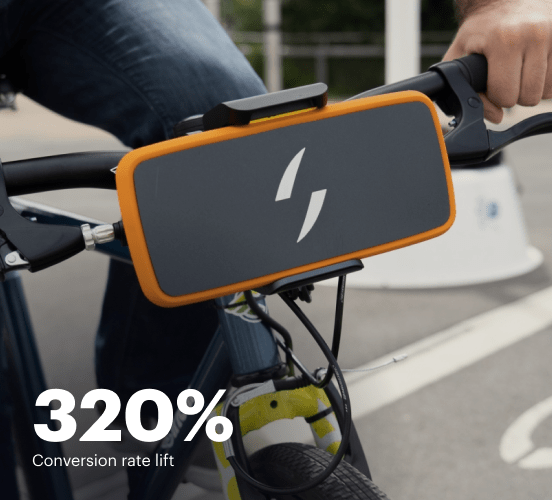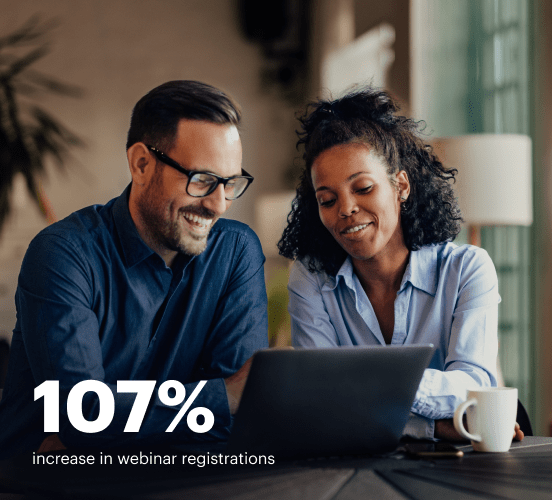How Webflow vs. Cognito Forms vs. Instapage stack up against each other
Compare Instapage with Webflow and Cognito Forms to create high-converting landing pages. With personalization, optimization, and collaboration tools, Instapage helps you deliver experiences that drive results.
Get startedSee how Instapage stacks up against the competition
| Feature | Instapage | Other builders |
| Drag-and-Drop Tools | ||
| Conversion-optimized templates | ||
| Manual and AI-powered A/B Tests | ||
| AI content suggestions | ||
| Popups and sticky bars | ||
| Canvas and grid blocks | ||
| Reusable and global elements | ||
| Form and popup builders | ||
| Built-in Heatmaps | ||
| Central analytics dashboard | ||
| Ad-to-page personalization and collections | ||
| Contacts, lists, and email | ||
| Dedicated, full-service CRO experts | ||
| Enterprise-ready platform |
Leading the way in building high-performing landing pages





Why Instapage is the smarter choice for your campaigns
Get everything you need to build, scale, and optimize high-converting landing pages—without coding.

Easier page building without coding
Instapage offers a flexible and seamless page creation experience with a library of 500+ conversion-focused layouts, Instablocks®, a drag-and-drop builder, and AI content generation. With technologies like Thor Render Engine®, you can create on-brand, mobile-responsive landing pages that load quickly and start converting during initial visitor clicks.

More insights — better results
Instapage lets you see in detail how each landing page experience and variation is performing so you can make targeted changes that boost page conversions. Use heatmaps for a better understanding of on-page activities, run A/B tests and AI-assisted experiments, and then track and evaluate results within robust analytics dashboards.

More personalized experiences
Instapage lets you quickly create high-performing landing pages tailored to each of your ad campaigns. Deliver personalized experiences for distinct audiences using dynamic text replacement. Effortlessly align specific advertisements to unique pages with AdMaps. Monitor audience-level metrics using our advanced data tools.

Built-in collaboration
Instapage collaboration capabilities bring your entire team together to speed up the process of landing page review, approval, and launch. No more frustrating and unnecessary revisions or edits scattered across emails. Provide instant feedback, conduct real-time page edits, and securely share your pages with outside stakeholders.

Free up time for your business
Invest time into business growth, not busy work. Launch landing pages faster with reusable forms and templates. Build once, reuse forever.
Explore all integrations






Easier page building without coding
Instapage offers a flexible and seamless page creation experience with a library of 500+ conversion-focused layouts, Instablocks®, a drag-and-drop builder, and AI content generation. With technologies like Thor Render Engine®, you can create on-brand, mobile-responsive landing pages that load quickly and start converting during initial visitor clicks.
More insights — better results
Instapage lets you see in detail how each landing page experience and variation is performing so you can make targeted changes that boost page conversions. Use heatmaps for a better understanding of on-page activities, run A/B tests and AI-assisted experiments, and then track and evaluate results within robust analytics dashboards.
More personalized experiences
Instapage lets you quickly create high-performing landing pages tailored to each of your ad campaigns. Deliver personalized experiences for distinct audiences using dynamic text replacement. Effortlessly align specific advertisements to unique pages with AdMaps. Monitor audience-level metrics using our advanced data tools.
Built-in collaboration
Instapage collaboration capabilities bring your entire team together to speed up the process of landing page review, approval, and launch. No more frustrating and unnecessary revisions or edits scattered across emails. Provide instant feedback, conduct real-time page edits, and securely share your pages with outside stakeholders.
Free up time for your business
Invest time into business growth, not busy work. Launch landing pages faster with reusable forms and templates. Build once, reuse forever.
Explore all integrationsGet started with Instapage in a few steps
-
Create your Instapage account
Start with Instapage by signing up via Google or your email. You'll get access to a free 14-day trial to discover Instapage capabilities. Feel free to cancel anytime during the 14-day trial if you decide that our product is not suitable for your business. -
Build and personalize your page
Create your first landing page from scratch or choose a template from 500+ customizable layouts. Use the drag-and-drop builder to add page elements, fonts, and backgrounds, refine content with AI, or add custom HTML, Javascript, and CSS. -
Review and make edits
Collaborate on page designs and streamline review processes. Invite your team members and stakeholders to review, edit, and provide feedback on your landing page. Collaborate knowing your page is confidential and only accessible to authorized users. -
Publish and track page performance
Publish your page to a domain or custom URL. Connect your pages to the ads you've created and track page performance within the analytics dashboard, run A/B tests and AI experiments, analyze results, and continuously optimize your landing page to maintain high conversions.
Instapage vs. Webflow vs. Cognito Forms – Which One Comes Out on Top?
Choosing the right landing page builder is much like assembling a dream team of superheroes, each one bringing their unique powers to the table in order to conquer the challenges of digital marketing. You need effective tools that can address your marketing goals, ace at conversions, and help create meaningful user experiences. In this showdown, we explore how Instapage, Webflow, and Cognito Forms stand out, not merely as rivals but as essential players that can transform the landscape of your online presence. With a focus on Instapage's strengths in reducing costs, enhancing conversions, and delivering tailor-made landing experiences, we're ready to help you understand who truly deserves the crown. We'll dive into features, performance, usability, support, and pricing to determine which platform can best turn your marketing strategy into a winning game plan. Let's leap into the arena with these legendary contenders at the ready! (min:200 words)
The Assorted Champions Step Forward
In the red corner, we have Instapage, known for its impressive customization options and robust conversion optimization tools. In the blue corner, Webflow brings a unique blend of design freedom and developer capabilities, making it appealing to more tech-savvy users. And in the green corner, Cognito Forms, often recognized for its excellent form-building capabilities, rounds out our trio. Each of these platforms has carved out a niche in the competitive landscape of landing page solutions, addressing various needs and catering to different segments of marketers and businesses. Instapage empowers marketers to reduce costs, grow conversions, and deliver relevant landing page experiences that increase brand trust, customer loyalty, and conversion rates. In contrast, Webflow's flexibility and design-centric approach make it a hot favorite among creative professionals. Meanwhile, Cognito Forms captures the spotlight with its easy-to-use form features, making data collection a breeze. As we explore these contenders in further rounds, let's see how they stack up against one another. (min:200 words)
Round One - Feature Showdown
Examining Template Diversity and User Accessibility
When it comes to landing pages, the first impression often relies on visually appealing designs and user-friendliness. Instapage offers a plethora of pre-designed templates, ensuring that marketers can swiftly launch beautiful landing pages tailored to their branding. The drag-and-drop interface is designed to foster seamless user experiences, making customization straightforward even for less tech-savvy individuals. On the other hand, Webflow dazzles with nearly limitless design freedom, appealing to users with sophisticated coding skills who want to create highly personalized layouts. However, this flexibility may come with a learning curve that could deter absolute beginners. Cognito Forms sits differently in this round because its strength is less about landing pages and more focused on form creation. It offers user-friendly templates primarily designed for data collection, which means that while it can integrate into landing pages, it may not have the same emphasis on designed experiences that Instapage and Webflow prioritize. (min:200 words)
Instapage: Your Go-To for Customization and Conversion Mastery
Instapage redefines what marketers come to expect from landing pages. Its unmatched customization capabilities allow users to create unique experiences tailored to their audience segments. More than just a tool, Instapage serves as a valued partner in optimizing your conversion rates by providing A/B testing, analytics, and performance insights right at your fingertips. Marketers can adjust layouts, copy, and images quickly to discover what resonates most with their audience. Beyond this, the platform features a vast library of conversion-optimized templates that are easy to modify, taking the guesswork out of design. Features like custom domains, adaptable landing page designs for various platforms, and seamless integrations with marketing tools illustrate how Instapage equips users to grow their conversions while ensuring brand integrity. While Webflow and Cognito offer distinct features, it’s clear that Instapage stands out as the ultimate choice for marketers focused on conversion optimization. (min:200 words)
Round Two - The Speed and Performance Factor
Now, let’s address a critical aspect in the realm of web experiences—speed and performance. Think of the loading speed of a landing page as the swift coffee barista who knows how to deliver your drink just right and in record time; if he takes too long, you might just walk away. The same principle applies to your prospective customers; slow-loading pages can lead to lost interactions and reduced conversions. With Instapage, you can expect above-average loading times thanks to their optimized infrastructure designed specifically for landing page delivery. Moving to Webflow, users generally report reliable performance, though resource-heavy designs can sometimes slow down loading times. Meanwhile, Cognito Forms, despite focusing on form capabilities, also provides fast integration options; however, its performance may vary depending on how well the forms are embedded into landing pages. When evaluating these platforms, think carefully about the importance of page speed, as it plays a pivotal role in overall user satisfaction and conversion rates. (min:200 words)
Advantages of Instapage:
- Optimized for fast load times, ensuring user engagement.
- Robust infrastructure specifically geared towards landing page performance.
- Advanced performance tracking and A/B testing tools.
- User-friendly setup facilitates quick launch of campaigns.
Advantages of Webflow:
- Well-designed pages typically maintain good load speeds with lighter designs.
- Offers extensive customization, enhancing user experience.
- Responsive design capabilities for optimized mobile experiences.
Advantages of Cognito Forms:
- Quick loading interfaces for forms, ensuring data is collected effortlessly.
- Integration capabilities that can enhance overall performance.
- User-friendly interface that promotes efficient form-building.
In conclusion, when it comes to speed and performance among these three platforms, Instapage takes the lead thanks to its optimized structure and user focus. While Webflow and Cognito Forms offer solid performance, especially under certain conditions, the nuances of landing page creation underscore the importance of speed, especially for conversions. (min:200 words)
Round Three - Usability and Learning Experience
Every platform has its own unique learning curve, and usability is essential for both beginners and seasoned professionals alike. Instapage promotes ease of use with a highly intuitive drag-and-drop editor that enables users to create stunning landing pages without extensive training. This accessibility bridges the gap, allowing newcomers to start creating right away while still offering enough advanced features for experienced marketers. In contrast, Webflow may initially present a steeper learning curve, as its depth of features can overwhelm those who aren't already familiar with design principles. However, once mastered, it provides a rich canvas for creatives looking to push design boundaries. Cognito Forms, while primarily form-focused, excels in usability with straightforward tools for creating forms quickly. Each platform ultimately fosters a journey toward expert use, but that journey will vary greatly depending on your technical skills and marketing goals. (min:200 words)
Round Four - Customer Support Champions
Customer support can be likened to the trusty sidekick in your marketing journey, swooping in to save the day when issues arise or questions come up. Instapage excels with its dedicated support team, providing immediate assistance through live chat and email support, alongside a wealth of tutorials and a comprehensive knowledge base. Webflow users also benefit from a vibrant community and extensive documentation, although live chat support varies based on the plan chosen. Cognito Forms prides itself on approachable support options, including email assistance and resourceful community forums, which can be quite helpful for users. Each platform showcases its strengths in customer support, ensuring users can enjoy a smooth sailing experience, regardless of their expertise. (min:200 words)
Round Five - Analyzing Pricing Structures
Evaluating pricing can often feel like walking through a maze; finding the right plan starts with clearly identifying your needs. Instapage offers tiered pricing plans tailored to various business sizes, making it suitable for larger marketing teams who will benefit from its advanced features. In contrast, Webflow provides a unique pricing model based on project size and complexity, which can appeal to freelancers and agencies alike but could become pricey for heavier users. Cognito Forms operates on a straightforward subscription model, focusing primarily on form-building solutions, making it a budget-friendly option for businesses needing solid data collection capabilities. Each of these solutions serves different financial needs and objectives, calling for careful consideration of where to invest for the best returns. (min:200 words)
As we wrap up this friendly comparison, remember that each platform holds its own unique advantages. The key to selecting the right tool hinges on recognizing your specific objectives and what you value most in a landing page builder—whether that’s intuitive features, responsive support, or flexible pricing. Don’t hesitate to explore Instapage with a free trial or demo to see firsthand how it can deliver relevant landing page experiences while increasing brand trust, customer loyalty, and boosting conversion rates. Your perfect landing page is only a decision away! (min:200 words)










